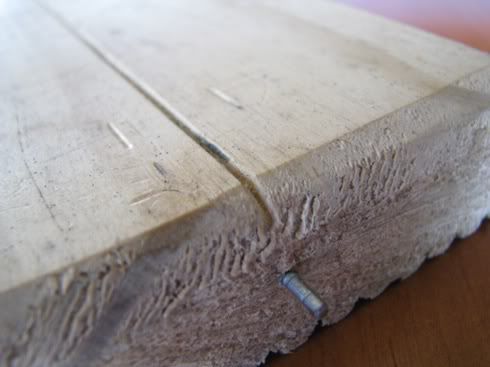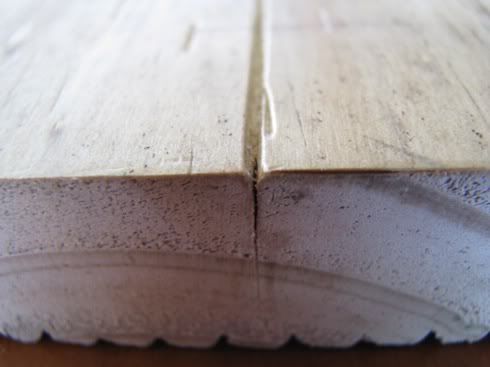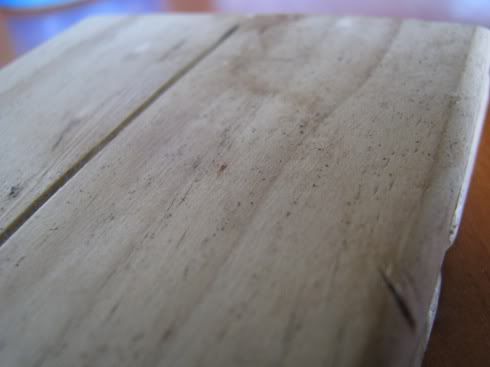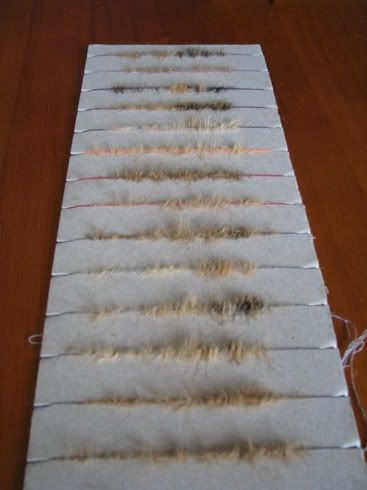Clark's dubbing block
Moderators: letumgo, William Anderson
-
CreationBear
- Posts: 1156
- Joined: Sun Jun 20, 2010 6:35 pm
Re: Clark's dubbing block
Mike--thanks for the insights and the pictures...neat rust/russet fur on your muskrat's belly. 
-
Mike Connor
Re: Clark's dubbing block
My pleasure. If you look very carefully at any dubbing mix and have a rough idea of what was used you can duplicate it accurately. The various textures in some mixes are AT LEAST as important as the colours used on some flies. Muskrat varies widely, ( as you can see from the pictures), the only "constant" really is the grey/blue underfur, although you can generally find some similar fur on various pelts. Just grabbing fur at random from such pelts results in very widely differing blends. The same applies to Hare fur. Once you have blended some stuff up it may look similar but it rarely is. Completely shaving a hare's mask for instance and blending the result ( which is apparently what many people do ) will indeed give a pretty good "general" wet fly dubbing, but you can be far more accurate if you choose your fur and blends carefully.CreationBear wrote:Mike--thanks for the insights and the pictures...neat rust/russet fur on your muskrat's belly.
How much effect this actually has on the catching capabilities of various flies is a moot point to an extent, and unless you have examples of blends that work well is really a matter of trial and error, although on many flies a darker thorax is far more effective than the same blend overall, as here for instance;



this fly is made entirely of various hare fur on light yellow silk. The head is coloured with brown marker before varnishing.
Graduating the dubbing from light to dark along the body also often makes flies much more effective. Certain amounts of guard hair are also better than too much in some flies, some flies use no guard hair at all etc. etc.
Using various fur also affects how a fly behaves and in more than a few cases certain blends work much better than others. At one time very specific descriptions of the fur used, or the blends, were quite common, but this is seldom given now. The general blends given in the original Hidy pictures are probably as good as you will get nowadays.
TL
MC
-
CreationBear
- Posts: 1156
- Joined: Sun Jun 20, 2010 6:35 pm
Re: Clark's dubbing block
Ha, that is one buggy looking fly.  A question: does a whole Englsih hare skin give you more options than simply the mask, or does the "face" have enough varieties of textures/colors for most applications?
A question: does a whole Englsih hare skin give you more options than simply the mask, or does the "face" have enough varieties of textures/colors for most applications?
-
Mike Connor
Re: Clark's dubbing block
You have a lot more options with a whole skin, better if you have a few skins to choose from, culled or obtained at various times of year for the full colour and texture range, although there is more actual colour and texture variation on a mask. Can be hard to obtain whole skins and quality varies a lot, as it does with masks. "Quality" here refers to the quality required for fly-dressing, good colours no damaged hair etc. The best masks and other hair for many things comes from old jack hares in spring time.CreationBear wrote:Ha, that is one buggy looking fly.A question: does a whole Englsih hare skin give you more options than simply the mask, or does the "face" have enough varieties of textures/colors for most applications?

TL
MC
-
Mataura mayfly
- Posts: 3648
- Joined: Thu Oct 27, 2011 6:28 am
- Location: Southland, South Island, New Zealand.
Re: Clark's dubbing block
First off, Mike has added some wonderful stuff here and I am sure many gained a lot from it. Well done!
Secondly, the Clark block is something that has caught my attention and has been on my "to do" list for a couple of weeks thanks to the inspiration and photographs provided by many of the members here.
Many in this forum have been tying for years, with some of the best equipment and materials available, others like myself are relative novices and make do with what we can find.
The main reason behind this post was to show that even with limited means and materials the Clark block is not out of reach for anyone capable of tying a fly. The block need not be from some exotic hardwood or finished to a gloss you can see yourself in.
I searched and found very little on the internet in regard to making or sizing of blocks and a lot of what I did find was for mechanical spinners and big flies, not really suited to flymph tying. So I decided in good old Kiwi fashion to have a go at making one. This was to be an "experiment", if it worked then more time, material and expense could be spared in making a block that whilst looking better may not work any better!
The block pictured below is made from scrap pine decking, 5.5 X 4 X 3/4". The groove in the middle was formed by a marking gauge and an exacto knife used to make the thread holding slits at the bottom and right side. The top edge is rounded over by a hand plane, then a small finishing nail was driven below and inline with the top groove. Head cut from the nail with pliers and then filed/ sanded smooth so as not to catch and/ or cut the thread.

Close ups of nail, groove and knife cuts. (note* no sandpaper used here! )
)



Which has led to my first attempts at making bodies. Again on the "cheap" with craft store embroidery cotton, paste boot wax and self harvested Hare mask.

Secondly, the Clark block is something that has caught my attention and has been on my "to do" list for a couple of weeks thanks to the inspiration and photographs provided by many of the members here.
Many in this forum have been tying for years, with some of the best equipment and materials available, others like myself are relative novices and make do with what we can find.
The main reason behind this post was to show that even with limited means and materials the Clark block is not out of reach for anyone capable of tying a fly. The block need not be from some exotic hardwood or finished to a gloss you can see yourself in.
I searched and found very little on the internet in regard to making or sizing of blocks and a lot of what I did find was for mechanical spinners and big flies, not really suited to flymph tying. So I decided in good old Kiwi fashion to have a go at making one. This was to be an "experiment", if it worked then more time, material and expense could be spared in making a block that whilst looking better may not work any better!
The block pictured below is made from scrap pine decking, 5.5 X 4 X 3/4". The groove in the middle was formed by a marking gauge and an exacto knife used to make the thread holding slits at the bottom and right side. The top edge is rounded over by a hand plane, then a small finishing nail was driven below and inline with the top groove. Head cut from the nail with pliers and then filed/ sanded smooth so as not to catch and/ or cut the thread.

Close ups of nail, groove and knife cuts. (note* no sandpaper used here!



Which has led to my first attempts at making bodies. Again on the "cheap" with craft store embroidery cotton, paste boot wax and self harvested Hare mask.

"Listen to the sound of the river and you will get a trout".... Irish proverb.
-
Mike Connor
Re: Clark's dubbing block
Try using a paper glue stick instead of wax. This washes out when the fly is fished, but it holds together much better than wax on the dubbing block. You can also use this for "touch" dubbing.One like this for instance;
http://www.officedepot.com/a/products/9 ... erralID=NA
For some good dubbing info;
http://www.wildfisher.co.uk/smf/index.php?topic=11416.0
TL
MC
http://www.officedepot.com/a/products/9 ... erralID=NA
For some good dubbing info;
http://www.wildfisher.co.uk/smf/index.php?topic=11416.0
TL
MC
Last edited by Mike Connor on Sat Jan 28, 2012 7:17 pm, edited 1 time in total.
-
CreationBear
- Posts: 1156
- Joined: Sun Jun 20, 2010 6:35 pm
Re: Clark's dubbing block
That's a great bit of information, though I doubt I'll ever have the opportunity to sift through that many pelts when I'm in the UK next, much less be confident about getting them through Customs!The best masks and other hair for many things comes from old jack hares in spring time.
-
Mike Connor
Re: Clark's dubbing block
It's unlikely you will even find any whole hare pelts in the UK. I have not seen any for sale for a long time now, and there never were many. You might be able to buy Argentinian pelts, ( same animal, Lepus europaeus ).CreationBear wrote:That's a great bit of information, though I doubt I'll ever have the opportunity to sift through that many pelts when I'm in the UK next, much less be confident about getting them through Customs!The best masks and other hair for many things comes from old jack hares in spring time.
http://www.gisp.org/casestudies/showcas ... =&country=
TL
MC
-
Mataura mayfly
- Posts: 3648
- Joined: Thu Oct 27, 2011 6:28 am
- Location: Southland, South Island, New Zealand.
Re: Clark's dubbing block
I have sent many a bag of clipped Hare fur through the post from here in NZ to the States, never had one interrupted yet (touch wood). I have sent pelts or parts of, but then you have the hassle of tanning and preserving before you send them. Easier for the receiver when the fur is still attached though, otherwise you end up with the generic dubbing Mike talked of earlier, a jumble of guard hair and underfur. Interestingly the underfur can run from white through to grey/blue from the one pelt but in different areas.CreationBear wrote:That's a great bit of information, though I doubt I'll ever have the opportunity to sift through that many pelts when I'm in the UK next, much less be confident about getting them through Customs!The best masks and other hair for many things comes from old jack hares in spring time.
"Listen to the sound of the river and you will get a trout".... Irish proverb.
-
Mike Connor
Re: Clark's dubbing block
I don't bother tanning, just scrape well and salt them. When the salt is completely dry, wash in hot soapy water, allow to dry. Gives a texture like parchment. Works well if you just want stuff for fly-dressing. If you want to make fur coats and the like then you need to tan, and it's a lot harder to do!
TL
MC
TL
MC
